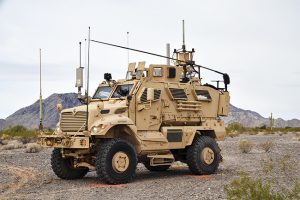The Army said Thursday it has awarded a pair of deals to General Dynamics Mission Systems [GD] and Lockheed Martin
[LMT] to begin work developing a new long-range electronic warfare (EW) capability.
The two companies were selected for the first phase of the Terrestrial Layer System–Echelons Above Brigade (TLS EAB) program, expected to be worth around $15 million, while the Army noted the overall value of the prototype program could total $163 million.

Ken Strayer, the Army’s project manager for EW and cyber, described TLS EAB as an “extended-range, terrestrial sensing, collection, and electromagnetic attack system” that will provide signals intelligence, EW and cyber capabilities for “situational awareness, situational understanding, indications and warnings, command post protection operations, and to support the delivery of lethal and non-lethal effects in a holistic, synchronized manner for large-scale combat operations.”
“Coupled with the TLS Brigade Combat Team (TLS BCT) system, soldiers at all levels will have the ability to support Multi-Domain Operations with EW situational awareness and effects options,” Strayer said in a statement.
The Army said last month it awarded Lockheed Martin a $59 million deal to provide TLS BCT prototypes for operational assessment, with the program aiming to provide an integrated suite of signals intelligence, electronic warfare and cyber capabilities on Stryker vehicles (Defense Daily, July 13).
After Lockheed Martin had participated in a competitive first phase of TLS-BCT, the Army awarded the company a $9.6 million deal last September to continue work developing the Stryker-integrated suite of systems.
The Army has previously said TLS-EAB is likely to be integrated on heavier vehicles, such as Family of Medium Tactical Vehicle trucks, to provide advanced ground-based jamming capabilities from longer distances.
Phase 1 of TLS EAB will have both GD Mission Systems and Lockheed Martin participating in a competitive developmental process, to include concept design, system design review and a software architecture demonstration, according to the Army.
“All design, build, and testing of the TLS EAB prototypes will be executed in concert with active duty soldiers of the appropriate Military Occupational Specialties to ensure a user focused experience,” the Army wrote in its announcement.